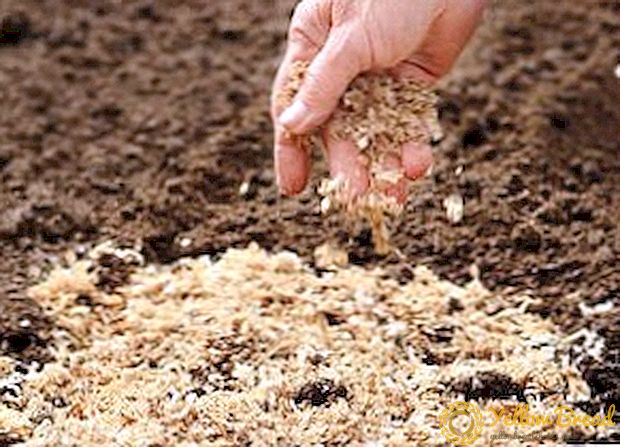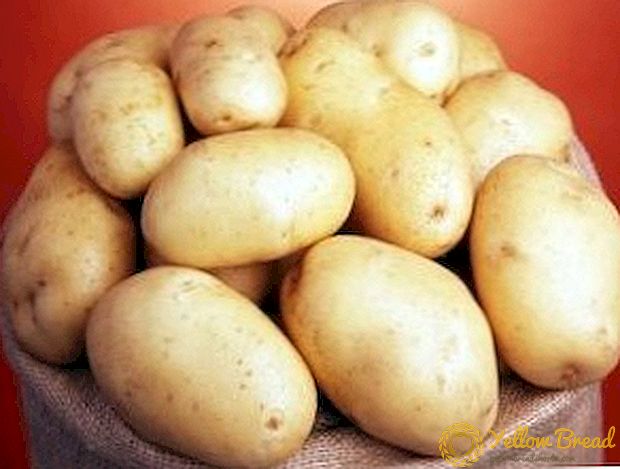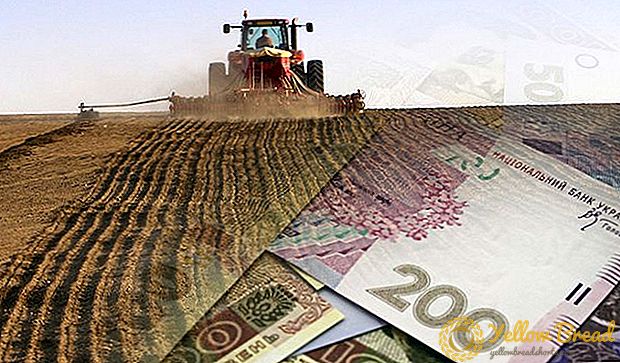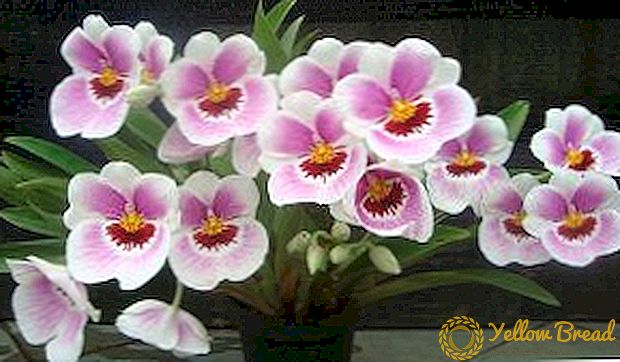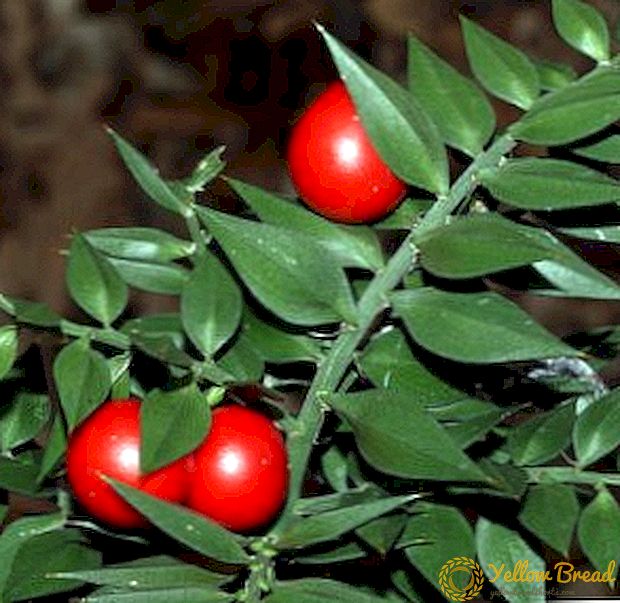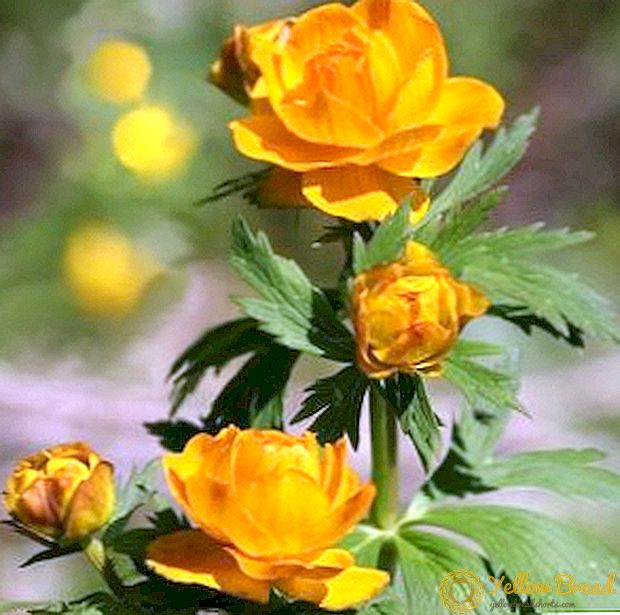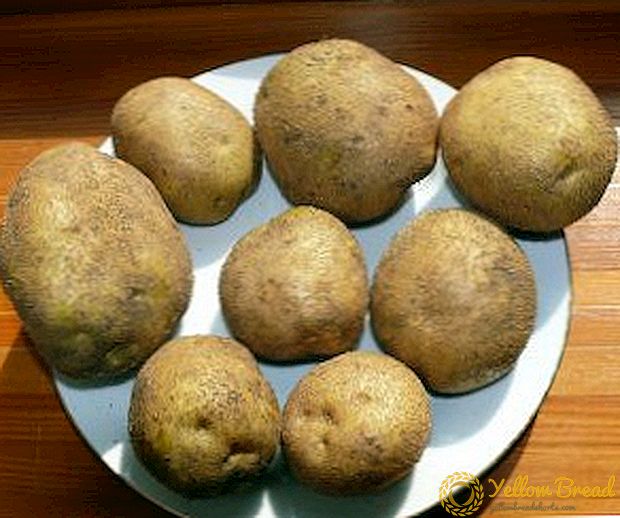 Potatoes variety "Veneta" (or "Vineta") is very popular potato growers in the post-Soviet space.
Potatoes variety "Veneta" (or "Vineta") is very popular potato growers in the post-Soviet space.
This variety of tubers is characterized by simplicity in cultivation and excellent taste qualities of the harvested crop.
In this article we will talk about the characteristics and description of the variety "Veneta", as well as how to grow a large crop of potatoes in his country house.
- Description and photo
- Shoots
- Fruit
- Characteristic variety
- Advantages and disadvantages
- How to plant potatoes
- Place to grow
- Tuber selection
- Planting potatoes
- Grade Care
- Watering and fertilizer
- Weeding, loosening, hilling
- Protection against diseases and pests
- Harvesting and Storage
Description and photo
Tuber "Veneta" are dessert variety, so they are often used to prepare fried potatoes or french fries.
Shoots
Bush sredneraskidisty, upright. Shoots grow straight, their height reaches 60-70 cm. The leaves are painted in bright green color, at the edges have a slight waviness. The corolla is small, often beige and white. About 10-12 fruits can be formed under one bush.
Fruit
The fruits of potato varieties "Vineta" are oval-rounded and slightly oblong. The peel is dark yellow or light brown in color, the flesh is slightly lighter than the peel and often the color of an unripe banana. In the section, the tubers have a subtle net covering. Eyes on potatoes of this variety are rather small, and if you don’t look closely, you can hardly notice it. 
The average weight of tubers is 80-90 g. The starchiness of fruits does not exceed 15.5%. If you follow the correct cultivation agrotechnology, the taste of the tubers will be at the highest level.
Characteristic variety
Potato variety "Veneta" is an early ripe dessert. It possesses high taste qualities of fruits and excellent yield. With the observance of the agrofone and all agrotechnical requirements, from 1 hectare of potato plantations can be harvested from 235 to 239 centners of the crop.The variety has good drought resistance and resistance to many varietal diseases.
Veneta is especially popular among potato growers in Central Asia, where the problem of regular precipitation always remains pronounced. Due to the fact that the fruits of "Veneta" do not disintegrate even after a rough heat treatment, they are actively used to prepare a variety of dishes: soups, stews, salads, french fries, etc. 
Advantages and disadvantages
This potato variety has many advantages, which force more and more potato growers to grow exactly Veneta:
- high marketability: from 85% to 97%;
- early maturing and more friendly ripening of tubers;
- taste is very high, you can use to cook absolutely any dishes;
- persists in optimal conditions for a long time;
- the leaves of the shoots are not curled;
- suitable for growing in regions with rare precipitation;
- resistant to many varietal diseases: banded and wrinkled mosaic virus, potato cancer, etc.d .;
- Immune to various types of mechanical damage;
- unpretentious to the composition of the soil for cultivation.
 Disadvantages in this type of potato is not highlighted. Is that some gardeners say that the variety may be affected by blight, so you need to deal with it in a timely manner.
Disadvantages in this type of potato is not highlighted. Is that some gardeners say that the variety may be affected by blight, so you need to deal with it in a timely manner.How to plant potatoes
If you follow the basic rules of planting tubers, you can get a friendly return of early vegetable products.
Place to grow
It is best to grow potatoes on sandy, sandy, mineral or loamy soils. Cultivated peatlands are also suitable for cultivation. However, it is undesirable to plant potatoes on heavy loamy and clay soils. Winter cereals are considered the best forerunners of tubers. However, in no case should you plant "Veneta" in the place where tomatoes grew in the past year, since these two vegetables are affected by the same diseases.
 Potatoes, unlike other crops, need 4-5 times more oxygen.Therefore, before planting, the soil must be loosened and aerated, and then moistened. The tubers in the process of growth expand, so the soil for planting should be light and loose. Loosening should be carried out twice: in autumn and spring (just before planting).
Potatoes, unlike other crops, need 4-5 times more oxygen.Therefore, before planting, the soil must be loosened and aerated, and then moistened. The tubers in the process of growth expand, so the soil for planting should be light and loose. Loosening should be carried out twice: in autumn and spring (just before planting).Tuber selection
The selection of tubers for planting begins a few weeks before planting. You need to select the tubers of medium size with small eyes. The rotten planting material is immediately discarded. Experts recommend to treat the planting material with a solution of boric acid or an aqueous solution of manure. Such procedures can strengthen the protective forces of tubers.
If you are going to buy planting material on the market, then give preference to exotic or elite varieties of potatoes. The fact is that such varieties due to their rarity in our region will be much less exposed to various diseases. But, unfortunately, only the first 3-4 years.
Planting potatoes
Plant the potato "Veneta" in late April or early May. Since the variety is early ripe, in some southern regions the planting is made even earlier. The most important thing is that by the time you want to carry out the landing work, the night frosts should stop completely.
When planting, the tubers are buried in well-loosened soil by 7-10 cm. If the soil has not been aerated, the depth should be reduced by 30-35% (but it is better not to plant potatoes in such soils, since the quality and quantity of the crop will decrease sharply). The distance between rows of tubers should be about 60-70 cm, between tubers in a row - 25-30 cm. These numbers are reference, and it is desirable to keep them, because if the distances are not kept, then problems may arise when hilling and harvesting.

Grade Care
Proper and timely care - the success of high-quality crops. Although this variety is not particularly picky in the care, but you can’t let things go to chance.
Watering and fertilizer
In the southern regions of Russia and Ukraine, this potato variety needs watering. We have previously notedthat Veneta is a drought-resistant type of potato, and this is true; However, if we neglect irrigation in particularly hot and arid regions, the level of quality and quantity of the crop will decrease dramatically. In the central and northern regions of Ukraine, as well as in the central and western regions of Russia with a moderately humid summer, you can forget about watering in general.
However, as experienced gardeners say, "Veneta" needs 3 irrigations for the whole season.: the first watering should be carried out immediately after the sprouting of the bushes, the second - in the process of budding, the third - at the end of flowering.
Water should be plentiful, as the soil should be soaked with water at least half a meter deep. To do this, you need to pour about 50 liters of water per 1 m². Watering is best done in the early morning, as in the hot period, the tubers can bake.  Feed potatoes begin about a month after planting. In some northern regions of Russia, feeding may be delayed until mid-June. The tubers respond well to top dressing with superphosphates, nitrogenous fertilizers, sulphates or potassium chlorides, etc. In the store, you can immediately pick up the complex fertilizer nitrogen-phosphorus-potassium with the marking 10:20:10. Figures mean the ratio of the elements in the package with additional feeding.Such fertilizers are applied according to the instructions along with watering.
Feed potatoes begin about a month after planting. In some northern regions of Russia, feeding may be delayed until mid-June. The tubers respond well to top dressing with superphosphates, nitrogenous fertilizers, sulphates or potassium chlorides, etc. In the store, you can immediately pick up the complex fertilizer nitrogen-phosphorus-potassium with the marking 10:20:10. Figures mean the ratio of the elements in the package with additional feeding.Such fertilizers are applied according to the instructions along with watering.
After the first feeding this process needs to be repeated two more times. The first time - when the buds appear, the second - after the end of flowering.
The variety also responds well to organic fertilizers, such as bird droppings. Bring it at the rate of 200 g per square meter. 
Weeding, loosening, hilling
Loosening and weeding are important steps in the process of caring for Veneta. If we allow the growth of weed on potato crops, the yield will drop sharply. In addition, a hard crust on the top layer of soil will lead to the fact that the tubers will receive little oxygen, as a result, their quality will also decrease.
Loosening is carried out with the help of a rake. The soil should be loosened until all large breasts of the earth have been removed. With a long spring, such processes are repeated at least 2-3 times. Also, do not forget about loosening immediately after watering. At such moments, you need to loosen the soil with the help of a hoe, but very carefully, so as not to damage the stems of the bush.
Weeding is done several times throughout the season.The number of weeds will depend on the frequency with which new weeds will appear on the plot. Weed potato aisle need hoe. In the process of weeding, the soil is immediately loosened, so two tasks can be solved at once.
 Almost all gardeners in our country consider hilling potatoes as one of the main stages of caring for them. There are different opinions about this. Some gardeners use deep planting potatoes - and the need for hilling is eliminated. Others use breakthrough technology - when potato tops are spread on the ground and covered with mulch, leaving only the tops. Both are satisfied with the results.
Almost all gardeners in our country consider hilling potatoes as one of the main stages of caring for them. There are different opinions about this. Some gardeners use deep planting potatoes - and the need for hilling is eliminated. Others use breakthrough technology - when potato tops are spread on the ground and covered with mulch, leaving only the tops. Both are satisfied with the results.In the central and northern regions of Russia, Veneta potatoes should be spudded when the bushes reach a height of 12-15 cm. In those regions where night frosts can continue until early summer, the hilling is carried out immediately after the first shoots from the soil make their way. But despite all this, this procedure is carried out only in the morning or in the evening.Also, the entire plantation is watered abundantly, or after rain.
Protection against diseases and pests
Most often potato crops strike the Colorado potato beetle. Every potato breeder knows how to deal with this pest. Colorado beetles constantly produce immunity to various chemicals, so it is very often necessary to carry out processing several times, and always with different preparations.
Gardeners and gardeners recommend destroying pests by mechanical means. For example - to collect the larvae of the beetle in dense containers with kerosene or salted water (in such mixtures they immediately die).  In the fight against the Colorado potato beetle will help an aqueous solution of urea. It is prepared at the rate of 100 g of urea per 10 liters of water, and then sprayed in the early morning or late evening. To prevent the occurrence of a pest, you can put a little onion peel in the pits when planting tubers.
In the fight against the Colorado potato beetle will help an aqueous solution of urea. It is prepared at the rate of 100 g of urea per 10 liters of water, and then sprayed in the early morning or late evening. To prevent the occurrence of a pest, you can put a little onion peel in the pits when planting tubers.
Chemical spraying is allowed no more than once every 6-8 days.
Against wireworms use bait made from slices of potatoes.They are buried shallowly in the ground, then dug back and destroy all the larvae.
To combat the bears they use traps based on boiled corn, millet, oilcake, wheat, etc.
To prevent the emergence of potato moths and nematodes on the site, you must comply with all quarantine measures. In order to prevent nematodes from appearing on the site, the soil is sprayed with thiazone 30 days before the beginning of planting (40%). To prevent the emergence of moth larvae, it is necessary to carry out processing with the help of 10% karbofos.  It is known that the variety "Veneta" may be affected by blight. As preventive measures, plantations should be treated with such chemicals: Ridomil Gold or Acrobat. Use according to the instructions; The first treatment is carried out when the bushes reach a height of 15-20 cm.
It is known that the variety "Veneta" may be affected by blight. As preventive measures, plantations should be treated with such chemicals: Ridomil Gold or Acrobat. Use according to the instructions; The first treatment is carried out when the bushes reach a height of 15-20 cm.
Harvesting and Storage
Immediately after harvesting the potatoes must be thoroughly dried in a warm ventilated area. In such a room should not get direct sunlight. In addition, high humidity is also undesirable. After drying, the potatoes of the variety “Vineta” need to be decomposed into grid bags and hidden in a cellar or cellar.The latter should have a ventilation system and optimum humidity.
"Veneta" is distinguished by excellent preservation. After 7-9 months after harvest, it will remain at 88% in the presentation; besides, its taste qualities will be saved at a high level.
Potatoes variety "Veneta" - unique in its taste and properties. Amino acids, which are contained in its composition, do not disappear even after heat treatment. Unpretentious care and high product quality make Vineto one of the best potato varieties today.

